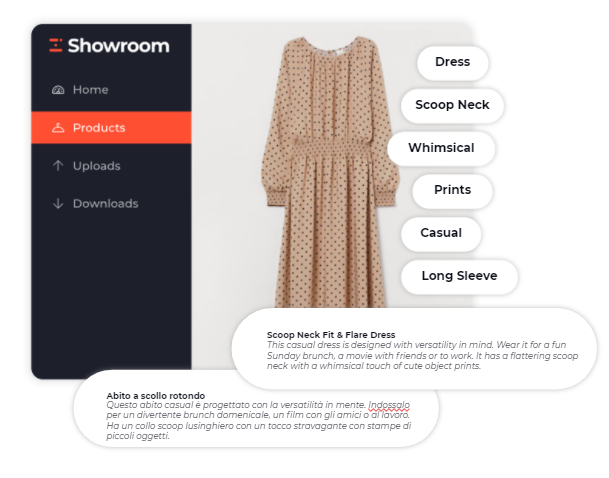
Articles
AI in Fashion E-commerce UX
You are here:
How vision AI simplifies product tagging, accelerates catalog production, and personalizes the shopping experience.
Physical vs. online store, the post-pandemic paradigm
With a 2020 sales contraction estimated between 35 and 40%, the pandemic has undoubtedly left its mark on the fashion industry, especially on all forms of in-store retail.
This global black-swan event has massively accelerated the digitalization of e-commerce and marketplaces in the fashion industry. Brands large and small across categories have jumped at the opportunity and sharply redirected their investments towards omnichannel shopping initiatives. Those retailers who have opted for more conservative strategies have experienced significant drops in turnover.
For example, Primark, the fast-fashion giant, lost € 890 million in revenues in 2020 compared to 2019, choosing to focus only on physical stores. Zara, instead, chose the opposite strategy. The company will close 1,200 stores and invest € 2.3 billion in digital transformation and integration between online and offline, over the next two years.
User experience, the key to standing out
The e-commerce user experience is built by optimizing countless consumer touchpoints, both digital and non-digital. It is fundamental to improve customer loyalty and to stand out among competitors.
The digital product catalog is one of the key elements to improve the user experience and influence the buying decision process, from the awareness to the purchase phase. Not only image selection is important, but also product information (metadata), which must be comprehensive, attractive, and in line with the style of the brand.
In practice, metadata includes a variety of e-commerce user interface (UI) attributes represented by product tags, such as color, material, fit, etc., and information embedded in product descriptions such as style, model, neckline, sleeve length, special accessories descriptors and more.
Why is catalog metadata important for e-commerce UX?
1. It improves the virtual shopping experience
If a customer is in the “discovery” phase, and therefore not looking for a specific product, metadata can improve the shopping experience to the point where it can influence a sale. For example, it enables more accurate search results, preventing the user from scrolling through countless items before finding the one they are interested in.
2. It increases product discoverability and SEO
The search algorithms of Google, Amazon or other marketplaces, prioritize results based on a complex and comprehensive analysis of the information available in the catalog. They analyze the search intent and prioritize the most relevant results. Having quality, rich and deep metadata for each product helps improve both SERP results and indexing in different marketplaces. This results in more organic traffic and better visibility for the brand, better e-commerce UI design, more direct browsing paths and entry points.
3. It supports a consistent and distinctive brand image
An iconic brand image is the currency of consumer communications in the fashion industry. For luxury brands, for example, which root their identity in the brand’s “heritage”, it is crucial to own their brand communication style and keep it consistent across every touchpoint, physical or digital.
Despite the growing importance of online channels and the consequent need to have a catalog with accurate and consistent metadata, today the major fashion brands must resort to slow and tortuous processes to ensure brand consistency in their online catalogs.
Why is the catalog production process suboptimal?
1. Lengthy, manual, and error-prone
In a typical organization, products are described and tagged manually. A full-time resource needs on average one week to tag between 200 and 300 items. This estimate does not take into account the time it takes to complete textual descriptions, an even more time-consuming and resource-intensive process.

Since these are creative and manual editorial activities, by their very nature, they are prone to errors and require close oversight, thus requiring a lot of quality assurance checks.
Consequences: + lead time; – flexibility; + costs
2. Expensive catalog localization
Many fashion brands need to translate their online collections into different languages. In some cases, native speakers are involved, even if they have different corporate roles. Other smaller brands use external agencies, increasing costs and time.
Consequences: + lead time; + overhead; – brand consistencys
How to automate the catalog process
Fortunately, technology, and in particular artificial intelligence (AI), can dramatically accelerate the product metadata extraction process for a brand’s entire online catalog and even help create on-brand descriptions.
For example, ContentWise, which uses AI to optimize the user experience, recently released Catalog Builder, an AI-powered solution that can generate tags and descriptions automatically, quickly, and consistently with brand guidelines, by analyzing product photoshoots.
Extracting meaningful data from images
The AI vision algorithm learns the brand’s communication style, codes, and “language” by ingesting images, photos, tags, and descriptions from past years’ collections.
After the initial training is complete, the AI is then fed new collections’ product artwork and catalog photoshoot images, and automatically generates on-brand tags and descriptions for each product.
By shifting the most tedious, error-prone tasks from a manual process, to an automated, AI-powered process, we free editorial and merchandising resources so that they supervise the AI, edit its output when necessary, and focus on the more creative elements of their work.
AI-generated, multilingual descriptions are deep and granular, so they can be readily used beyond the confines of a brand’s properties and fed to third-party channels and marketplaces such as Amazon, Zalando, eBay, Privalia and others.
What about the human touch?
The adoption of AI does not eliminate or replace the creative input, but rather enhances it, acting as a sort of intelligent assistant to the digital merchandising and marketing team. It takes care of tedious, manual activities, leaving skilled individuals the prerogative to add the “human touch” that an algorithm can never achieve.
Thanks to this technology, brands and retailers have significantly reduced time-to-market, shrinking the lead time involved in describing and tagging a product from hours to seconds. Significant time saving, cost reduction, and catalog quality improvements are achieved while safeguarding the stylistic and communicative code of the brand.

The application of AI technology to the fashion industry presents tremendous opportunities at every step of the value chain. It is especially well suited to elegantly resolve customer experience and productivity challenges that are pervasive in the industry.
Using AI to generate product metadata and descriptions for e-commerce catalogs can radically reduce errors, accelerate the process of launching new products and collections, simplify the editorial work, and ensure stylistic and brand consistency at scale.
At ContentWise, our mission is to help businesses engage customers at scale, through AI-powered digital experience technology. With Catalog Builder, Personalizer and our ContentWise Fashion offering we are helping fashion brands and retailers go to market more efficiently, deliver truly personalized experiences and increase e-commerce revenues.
Related News
Articles
Like VOD but in four dimensions? FAST channel programming automation and personalization with Contentwise Playlist Creator
Thanks to automation and AI, Playlist Creator, leverages content recommendation recipes to generate FAST channel playlists that are fed to cloud playout systems.

